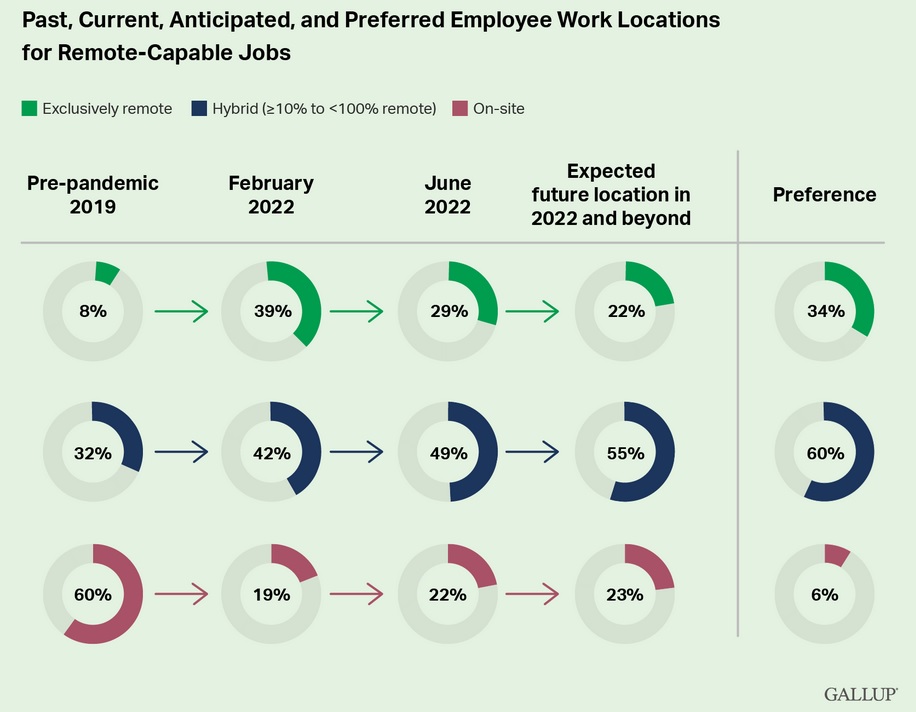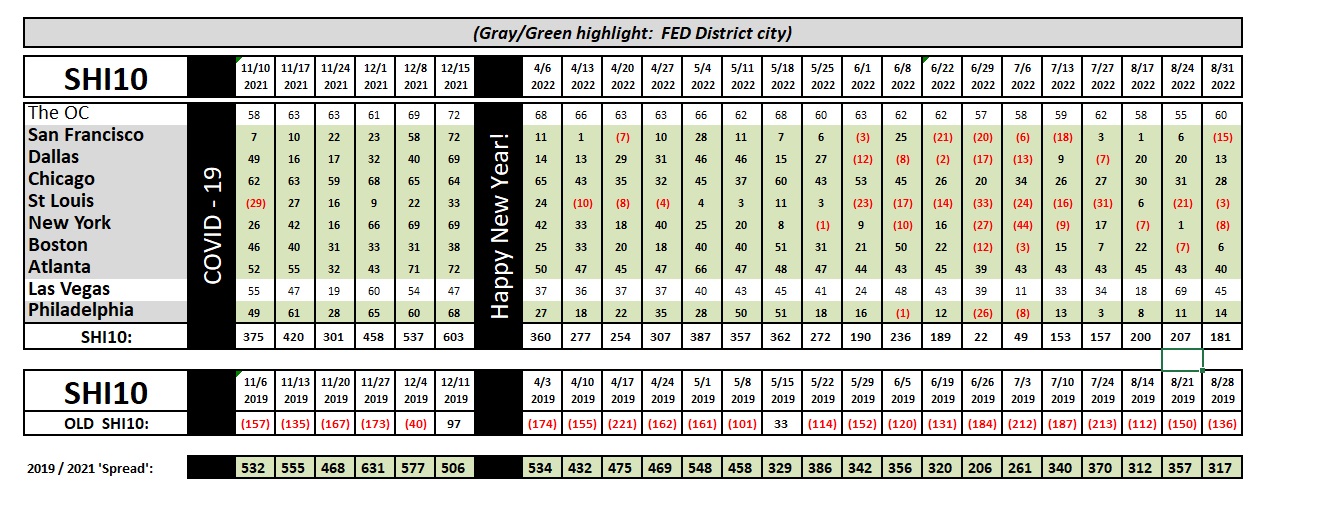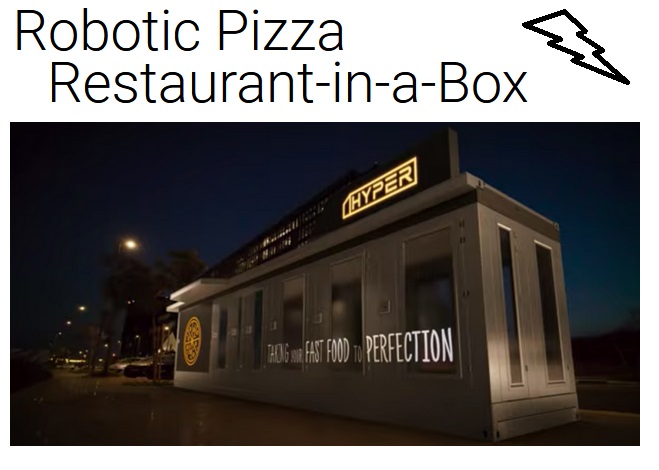SHI 8.31.22 – Supply and Demand for Steaks and Labor

SHI 8.24.22 – From FOMO to FOOP
August 24, 2022
SHI 9.7.22 – First, A Quiz!
September 7, 2022
Gallup polls started in 1935, right after the passage of the ‘Social Security Act,’ when 89% of Americans were in favor of “old-age pensions for needy persons.”
When asked in 1940, 62% of the American public believed defeating Germany was more important than staying out of the war. By 1949, 6% of households had a TV in their home and 62% of those polled thought TV “will someday take the place of radio in the home.” After the death of Stalin in 1953, 79% of those asked believed Russia still sought to be a “ruling power of the world.” In 1984, after Geraldine Ferrano became the Democrats VP candidate, 78% of Americans asked said they would “vote for a qualified woman for President.” And in June of 1999, the percentage of Americans who felt the economy was “good” or “excellent” reached 74%.
The history of polling is interesting. And Gallop has been in the poll business for more than 80 years.
“
What is Gallop saying about remote work?”
“What is Gallop saying about remote work?”
The concept of remote work took the main stage thanks to the pandemic. Remote work has changed home purchase decisions and patterns, has upended long-held beliefs in the labor markets, has emptied office buildings and the local business reliant on those tenants, and might become a permanent fixture. So what does remote work have to do with pricey steaks at our expensive eateries? Plenty.
Welcome to this week’s Steak House Index update.
If you are new to my blog, or you need a refresher on the SHI10, or its objective and methodology, I suggest you open and read the original BLOG: https://www.steakhouseindex.com/move-over-big-mac-index-here-comes-the-steak-house-index/
Why You Should Care: The US economy and US dollar are the bedrock of the world’s economy.
But is the US economy expanding or contracting?
Expanding. Sort of. At the end of Q2, 2022, in ‘current-dollar’ terms, US annual economic output rose to $24.85 trillion. Yes, during Q1, the current-dollar GDP increased at the annualized rate of 7.8%. The world’s annual GDP rose to about $95 trillion at the end of 2021. America’s GDP remains around 25% of all global GDP. Collectively, the US, the euro zone, and China still generate about 70% of the global economic output. These are the 3 big, global players.
The objective of this blog is singular.
It attempts to predict the direction of our GDP ahead of official economic releases. Historically, ‘personal consumption expenditures,’ or PCE, has been the largest component of US GDP growth — typically about 2/3 of all GDP growth. In fact, the majority of all GDP increases (or declines) usually results from (increases or decreases in) consumer spending. Consumer spending is clearly a critical financial metric. In all likelihood, the most important financial metric. The Steak House Index focuses right here … on the “consumer spending” metric. I intend the SHI10 is to be predictive, anticipating where the economy is going – not where it’s been.
Taking action: Keep up with this weekly BLOG update. Not only will we cover the SHI and SHI10, but we’ll explore “fun” items of economic importance. Hopefully you find the discussion fun, too.
If the SHI10 index moves appreciably -– either showing massive improvement or significant declines –- indicating growing economic strength or a potential recession, we’ll discuss possible actions at that time.
The Blog:
In an article published earlier today titled, “Returning to the Office: The Current, Preferred and Future State of Remote Work,” Gallop shared some interesting ideas, the result of a nationally-representative sample poll of 8,090 “remote-capable” US employees. Some of their findings include:
- <> 56% of full-time employees in the US believe their job can be done working remotely from home.
- <> 60% want a long-term ‘hybrid’ work arrangement.
- <> 34% want to work permanently from home.
- <> Only 6% want to work entirely on-site (at their place of employment) going forward.
Well. THAT’S interesting. Call me a curmudgeonly-old boss, but I find this stuff hard to believe. Employees in 56% of all jobs believe they can work from home? Really? That seems implausible to me. Not just because the waiters and support staff at Mastros simply cannot phone-it-in, but lets face facts: Retail, manufacturing, mining, construction, warehousing, logistics, health-care, education, leisure/hospitality, and the list goes on, all need their employees on-site. Most jobs within these industries absolutely require employees to show up at their place of work.
Regardless, Gallop has concluded (via extrapolation) that 70 million folks could work remotely. Remember, the US civilian labor force is about 165 million — so this means the US economy only needs 95 million people to work on-site … the rest could work from home … and everything’s fine? I don’t buy it.
Still, the history and projections are interesting:

Pre-Covid, 8% of the labor force worked remotely. The number is about 29% today. And only 6% of those asked “prefer” to work on-site. Ouch! I feel for those poor office buildings … and all the businesses — restaurants, day-care, personal care, etc — that rely on a robust and bustling central business district to avoid bankruptcy.
Perhaps the most interesting finding of all is the fact that 60% of those surveyed prefer some sort of hybrid work arrangement in the future. Almost double the figure pre-pandemic. Fascinating.
The tug-of-war between “labor” and “bosses” has been around as long as people. It is inevitable and permanent. Throughout history, there have been times when the “power” to dictate work conditions belonged exclusively to the bosses. For example, when Gallop first began polling in 1935 — the height of The Great Depression — the bosses had almost all the power. Employees had little or none, in most cases.
Today, the proverbial shoe-is-on-the-other-foot so to speak. The latest “job openings and labor turnover” report from the BLS came out yesterday. Like the FED, I was expecting the number of job openings to fall significantly. Nope. The opposite occurred. Job openings were up: Employers are hunting for over 11.2 million more new employees right now. Staggering.

After falling slightly in June, the number of “Job openings” rose again in July — something I did not expect. In a marketplace with 165 million “workers,” a 3.5% unemployment rate, and job openings of over 11 million, the “power” is firmly in the hands of labor. If they want to work from home today, they can probably find a boss who will let them. They have the power.
But not completely. For many reasons … but the least of which might be automation and technology. Consider this headline:
Hyper-Robotics Launches a
Robotic Pizza Restaurant-in-a-Box
Robotic pizza? What could be better?
Regardless, here’s the point: The Israeli company Hyper-Robotics manufactures “fully autonomous robotic restaurants.” And they just launched their first fully automated, robot pizza restaurant which can “pump out” up to “50 pies per hour.” That’s right: automated pizza. Pizza made — from dough to box — untouched by human hands. With up to 12 toppings! There is not a single employee to be found in the building. Check it out (right click, open in new tab):
Good, bad or otherwise, it appears employees at a Hyper robot restaurant can work remotely. Permanently remotely, if the video is to be believed, because they won’t have a job any longer. Of course, someone must “make” and set up the inputs … but once done, it looks like automated pizza is a thing. Good or bad … you decide. But remember: In 1949, 62% of those surveyed believed the TV would some day replace the radio in the home. 38% did not. Things change.
The supply of labor, and the demand for labor, will always be in flux. This relationship will likely never change. However, the group in control, the group with the power, at any moment-in-time will determine the current playing field rules — and right now, employees are saying they want to work from home. Employers would be smart to listen.
That said, the FED is working hard to shift this balance back into employers hands. If they get their way, after the series of rate increases slows the economy, unemployment should increase, “job openings” should fall, and “employment rules” will once again be firmly in the hands of the bosses. We don’t have to like it … I’m just sharing the facts.
Of course, Hyper-Robotics isn’t making any automated, high-priced steakhouses at the moment. Just pizza shops. Perhaps they never will. But like the relationship between bosses and their employees, TVs and radios, this too might change. To the steakhouses!

Not much change here from last week. Steady. Choppy … but steady.
Consumer spending remains the bedrock of the American economy. It appears solid today. But like the ever changing relationship between bosses and labor, the consumer is buffeted by the serious economic winds from FED rate increases and inflation. So far, they are holding up well. In fact, according to Fair Isaac, the aggregate US credit score has never been higher. Right now, the FICO national average is 716. Roughly 1/2 of all Americans have a score of 750 or above.
Those are some impressive numbers in light of the turbulence around the globe. The winds of change are blowing hard … so far, the consumer remains strong and a stalwart supporter of the American economy.
<:> Terry Liebman




